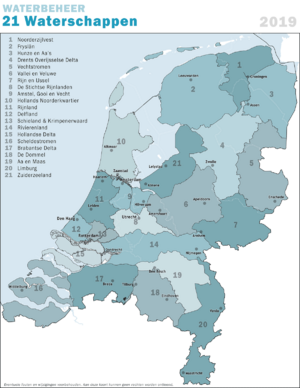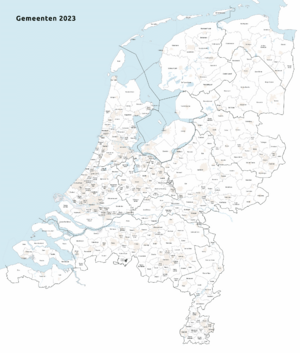Administrative divisions of the Netherlands facts for kids
The Netherlands is a country in Europe that is divided into different parts to help manage it better. Think of it like how your school might have different grades or departments!
The main ways the Netherlands is divided are into 12 provinces and 342 municipalities. These are the most important levels of government below the national one.
There are also 21 special areas called water districts. These districts are managed by a group called a water board (in Dutch, waterschap or hoogheemraadschap). Their main job is to take care of everything related to water, like keeping the country safe from floods. People vote for the members of these water boards every four years.
Groups of Provinces
Sometimes, the provinces are grouped together into larger areas called "Groups of provinces" (landsdeel in Dutch). These groups are used mainly for statistics by a European organization called Eurostat. They help compare different parts of Europe.
There are four of these groups in the Netherlands:
- Northern Netherlands
- Eastern Netherlands
- Western Netherlands
- Southern Netherlands
Provinces
The Netherlands has 12 provinces. These are the first big divisions of the country. Each province has its own capital city and is led by a King's Commissioner.
Here are the 12 provinces:
- Drenthe
- Flevoland
- Friesland
- Gelderland
- Groningen
- Limburg
- North Brabant
- North Holland
- Overijssel
- South Holland
- Utrecht
- Zeeland
Each province is made up of several smaller areas called municipalities. For example, the province of Gelderland has 51 municipalities, while Flevoland has only 6.
COROP Regions
A COROP region is another way the Netherlands is divided, but this time it's mostly for statistics. It's used by the official statistics office of the Netherlands. The name COROP comes from a Dutch phrase that means "Coordination Commission Regional Research Programme." These divisions are also used by the European Union for statistical purposes.
Water Boards
Water boards are very important in the Netherlands because a large part of the country is below sea level. Their job is to manage water, which includes things like:
- Keeping the dikes strong to prevent floods.
- Managing water levels in canals and rivers.
- Making sure the water is clean.
Each water board looks after a specific area, often based on natural watersheds or polders (land reclaimed from water). A single water board's area can cover many municipalities and even parts of different provinces! As of 2021, there are 21 water boards in the Netherlands.
Some examples of water boards include:
- Waterschap Noorderzijlvest
- Wetterskip Fryslân
- Waterschap Hunze en Aa's
- Waterschap Drents Overijsselse Delta
- Waterschap Vechtstromen
- Waterschap Vallei en Veluwe
- Waterschap Rijn en IJssel
- Hoogheemraadschap De Stichtse Rijnlanden
- Waterschap Amstel, Gooi en Vecht
- Hoogheemraadschap Hollands Noorderkwartier
- Hoogheemraadschap van Rijnland
- Hoogheemraadschap van Delfland
- Hoogheemraadschap van Schieland en de Krimpenerwaard
- Waterschap Rivierenland
- Waterschap Hollandse Delta
- Waterschap Scheldestromen
- Waterschap Brabantse Delta
- Waterschap De Dommel
- Waterschap Aa en Maas
- Waterschap Limburg
- Waterschap Zuiderzeeland
Municipalities
Municipalities (gemeenten in Dutch) are the second level of administrative division in the Netherlands. They are smaller than provinces and are part of them. As of January 1, 2023, there are 342 municipalities.
Each municipality has its own municipal council, which is like a local government. People vote for the members of these councils every four years. The central government gives municipalities certain duties to carry out.
Over time, many municipalities have joined together. This has reduced the total number of municipalities quite a lot since the 1800s.
Municipalities come in all shapes and sizes:
- The smallest municipality by land area is Westervoort, which is about 7 square kilometers (2.7 square miles).
- The largest is Súdwest-Fryslân, with a land area of about 523 square kilometers (202 square miles).
- Schiermonnikoog is the least populated and least crowded municipality.
- Amsterdam has the most people, with over 900,000 residents.
- The Hague is the most crowded, with many people living close together.
See also
 In Spanish: Organización territorial del Reino de los Países Bajos para niños
In Spanish: Organización territorial del Reino de los Países Bajos para niños




